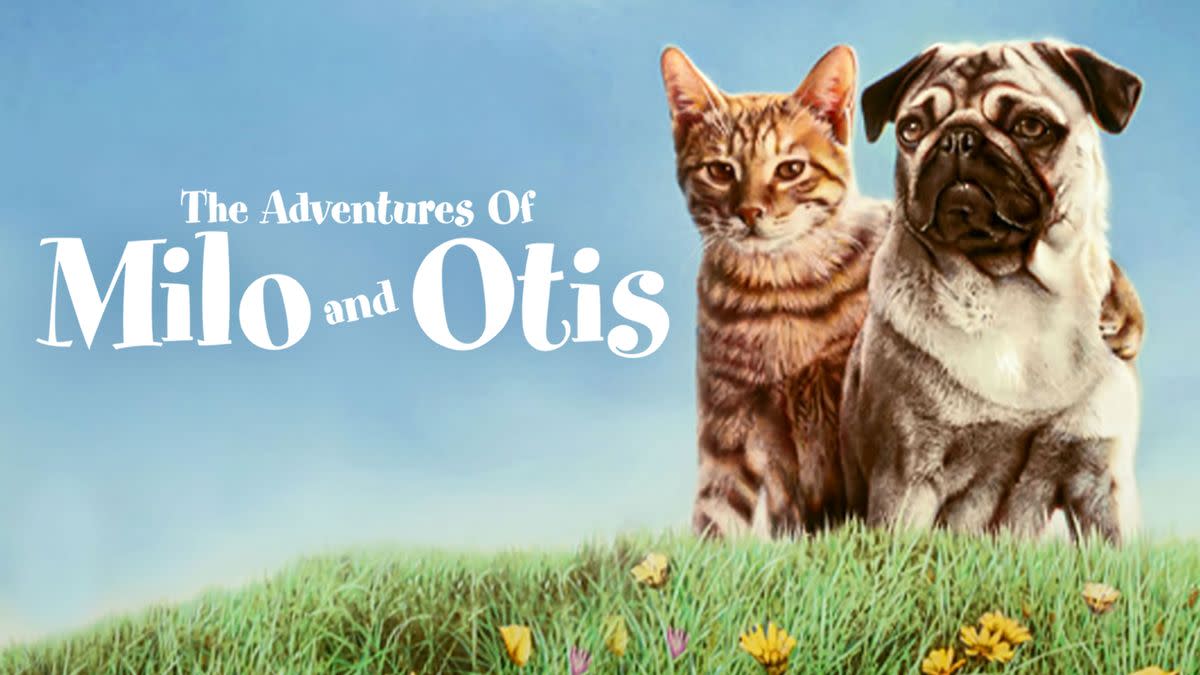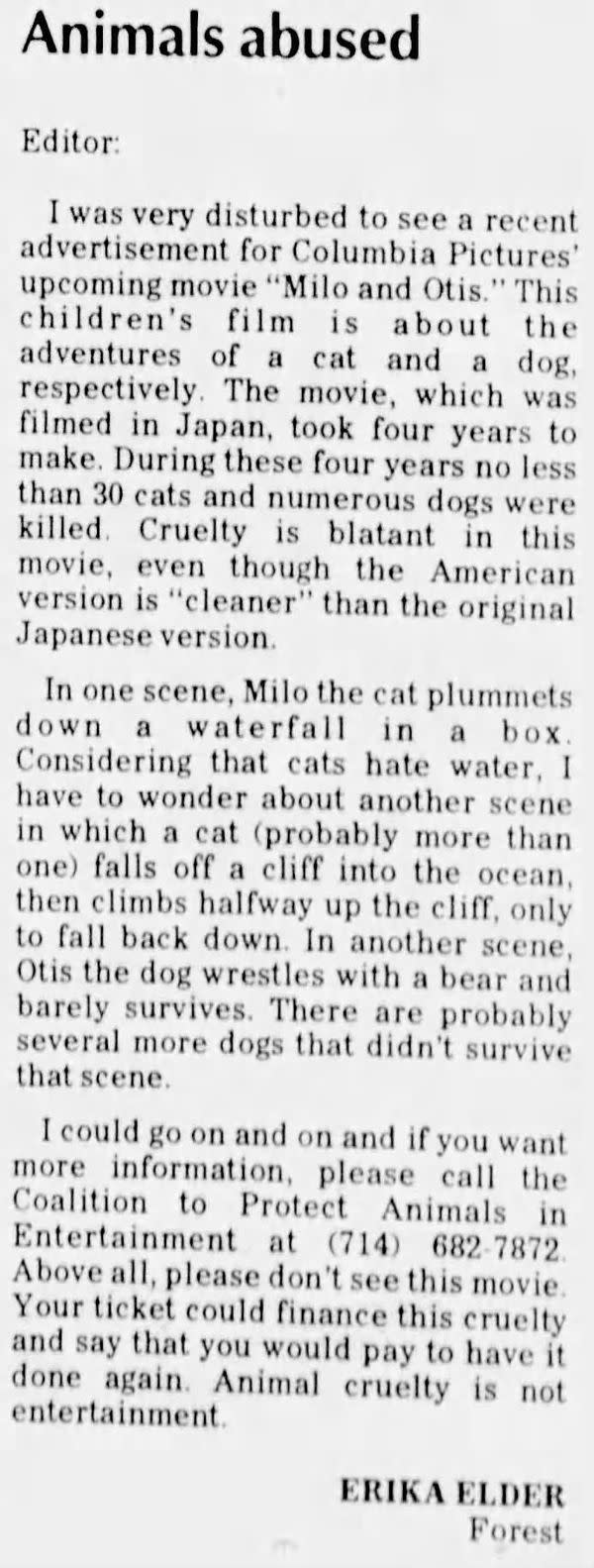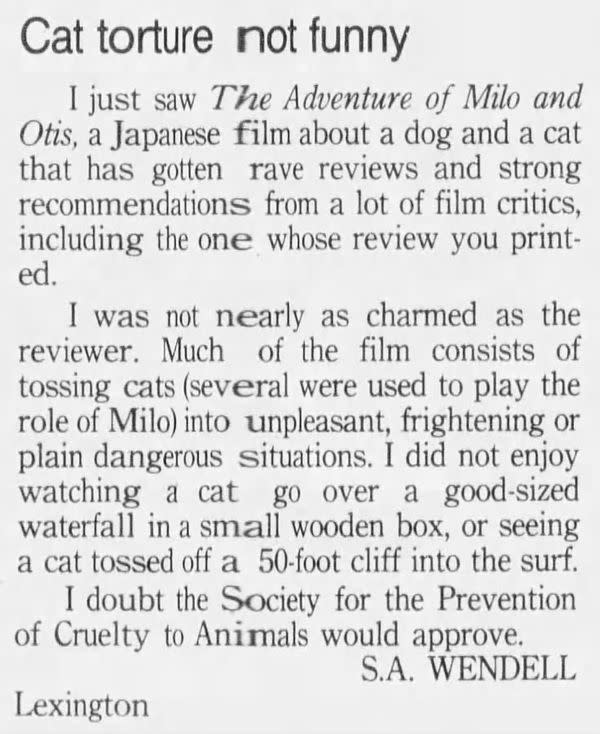Fact Check: Animals Allegedly Were Abused in Filming of 'The Adventures of Milo and Otis.' Here's What We Learned

- Oops!Something went wrong.Please try again later.
Claim:
Animals were harmed and/or killed in the making of the 1986 Japanese film, "The Adventures of Milo and Otis."
Rating:
Beloved to '90s kids everywhere, "The Adventures of Milo and Otis" is a 1986 Japanese film about a pug (Otis) as he follows an orange tabby cat (Milo) through a series of perilous obstacles. It was a massive hit, rising to Japan's number one film of 1986.
As one of the first and only films to use an entirely live cast of animals (no animation or CGI involved in production), it is loved for its adorable characters, whose clumsy blunders and narrow escapes from danger the English actor Dudley Moore narrates (Shigeru Tsuyuki in the Japanese version).
The unlikely friends evade attacks from multiple animals, including real bears, with one scene even depicting Milo "jumping" off a cliff to escape an attacking flock of seagulls. In an article from 2012 [archived here], PETA Australia wrote that "movies such as Milo and Otis ― for which, in order to get the right shot of a cat falling off a cliff, filmmakers simply threw the cat over the edge ― are seen as a thing of the past." Another scene shows a crab attacking a small cat, and many on the internet have alleged that a cat's paw was intentionally broken to make it look like it was walking unsteadily.
Over the years, viewers and animal-rights groups have raised questions about the safety of the animals involved in production, including claims that over 20 cats were killed and multiple dogs were mauled by a bear or drowned.
TIL during the filming of The Adventures of Milo & Otis many animal cruelty allegations were made against the film including the alleged killing of over 20 kittens, the director breaking a cat's paw, and a cat plunging over 100 feet off a cliff.
byu/meinthrowawayaccount intodayilearned
While many on the internet claimed that there was no solid evidence of abuse or the killing of animals in production, others pointed to the movie itself as evidence. "Watch the movie and use your judgement," one Reddit user wrote. Ask yourself how did they get this shot, did they put actually have to put the animal in danger and the answer is yes."
Following the film's 1986 release in Japan (and the 1989 release in the U.S. with 15 minutes worth of scenes deleted), two articles in particular are referenced as the source of abuse allegations. The first is an article in The Sunday Mail by P. Gillespie from 1990, and the other, also from 1990, published in Hobart Mercury by Brandt Teale. According to Dream Fiction Wiki [archived here]:
The Sunday Mail reported at the time that Animal Liberation Queensland founder Jacqui Kent alleged the killing of more than 20 kittens during production and added that she was disturbed by reports from Europe which alleged other animals had been injured, as in one case where a producer allegedly had broken a cat's paw to make it appear unsteady on its feet. Other scenes that were the source of controversy were the scene of a kitten falling off a cliff and a scene of a pug fighting a bear. Kent said her organization had a number of complaints from people who had seen the film and were concerned that it could not have been made without cruelty.
Although multiple sites aside from Dream Fiction Wiki, including the Wikipedia page for "The Adventures of Milo and Otis" [archived here] and Stack Exchange [archived here], cite these articles, we were unable to independently find these articles on the internet, archived or otherwise. This does not mean those articles never existed. We primarily searched on newspapers.com, an archival newspaper database.
Several clips of archived papers can be found in which concerned readers also alleged abuse, with two examples below from 1990:

(The News and Advance Lynchburg, Virginia, June 22, 1990)

(Lexington Herald-Leader Lexington, Kentucky, June 24, 1990)
"By radically downplaying the feral side of nature, 'Milo and Otis' offers a vision of the natural world that is awesome and occasionally fearful, but never terrifying," a 1989 New York Times review of the film read. "The nature photography has an almost hallucinatory beauty, and the extraordinary closeup photography of Milo and Otis, who were portrayed by an assortment of lookalike dogs and cats during the four years it took to complete the film, has an almost soulful quality."
The American Humane Association (AHA) published a report (archived link here from 2000), which found that:
The main character is a cat (played by 27 different cats). The picture shows no animals being injured or harmed. However, before it was released in the United States we heard rumors that some of the cats had died during the filming. We have attempted to investigate this through our contacts in Europe who normally have information on movies throughout the world. They had also heard the rumor, but were unable to verify it as being true. We have tried through humane people in Japan, and through another Japanese producer to determine if these rumors are true or not but everything has led to a dead end.
The AHA report also noted that various Japanese humane societies allowed their names to be used in connection with the movie:
Japan Society for the Prevention of Cruelty to Animals
Japan Animal Welfare Society
Japan Animal Protection & Administration Society
Japan Veterinarian Medicine Associations
Japan Pets Association
While most of the above organizations did not have email contacts listed publicly or message portals, we did reach out to Animal Welfare Japan, Animal Rights Center Japan, Japan Rescue Association, Humane Society International, and Japan Veterinary Medical Association seeking information regarding this claim. We will update this story if we receive a response.
We also sought comment via email from Sony Corporation, which acquired Columbia Pictures Entertainment (the distributer of "The Adventures of Milo and Otis") in 1989, the same year the film was released in the U.S. According to one blog post from 2006, "Columbia took great pains not to say 'no animals were harmed,' which has been boilerplate language on movie animal disclaimers for as long as anyone can remember."
Masanori Hata, the film's director alongside associate director Kon Ichikawa, is hailed today as someone who made "connecting humans with animals his life's purpose," whose "eyes shone with wisdom and kindness." On April 5, 2023, he died from a heart attack. He never publicly commented on the abuse allegations.
A little more than a decade prior to the release of "The Adventures of Milo and Otis," Japan passed the Act on Welfare and Management of Animals 1973. According to the act, killing or injuring an animal [included on the list of protected animals] is punishable with fines or imprisonment of up to two years. Even with this legislation in place, Japan's animal rights protections continue to rank low by international standards.
In sum, we were unable to independently verify whether these rumors had merit, as of this writing. As such, we have rated the claim "Unproven." If new information becomes available to us, we will update this story accordingly.
Sources:
Australia, PETA. 'Animals Were Harmed in the Making of This Movie - News'. PETA Australia, 6 Aug. 2012, https://www.peta.org.au/news/animals-were-harmed-in-the-making-of-this-movie/.
'Did Animals Really Die in the Making of "The Adventures of Milo and Otis?' Quora, https://www.quora.com/Did-animals-really-die-in-the-making-of-The-Adventures-of-Milo-and-Otis. Accessed 16 Apr. 2024.
Gillespie, P. 'Cat Cruelty Claim Over Kids' Movie'. [[The Sunday Mail (Brisbane)|The Sunday Mail]], 15 Apr. 1990.
Grace, Peter. 'Did Production of "The Adventures of Milo and Otis" Involve a Dramatically High Rate of Animal Deaths?' Skeptics Stack Exchange, 30 Aug. 2013, https://skeptics.stackexchange.com/q/17516.
Holden, Stephen. 'Review/Film; Cat and Dog Are Friends In a Tale of Real Animals'. The New York Times, 25 Aug. 1989. NYTimes.com, https://www.nytimes.com/1989/08/25/movies/review-film-cat-and-dog-are-friends-in-a-tale-of-real-animals.html.
Japan | World Animal Protection. https://api.worldanimalprotection.org/country/japan. Accessed 16 Apr. 2024.
Long, Crystal. 'Animal Abuse Rumors Plague 'The Adventures of Milo and Otis'. Wide Open Spaces, 8 Nov. 2023, https://www.wideopenspaces.com/milo-and-otis-deaths/.
Movie Review - "The Adventures of Milo and Otis ". 31 May 2001, https://web.archive.org/web/20010531234131/http://www.ahafilm.org/oldmovies1/theadventures/.
Movie & TV reviews for parents. The Adventures of Milo and Otis Movie Review | Common Sense Media. https://www.commonsensemedia.org/movie-reviews/the-adventures-of-milo-and-otis. Accessed 16 Apr. 2024.
Mutsugoro: Japan's Beloved Zoologist Masanori Hata Dies at 87. 6 Apr. 2023. www.bbc.com, https://www.bbc.com/news/world-asia-65198505.
No Country For Dead Dogs – Subversify. 18 Jan. 2013, http://subversify.com/2008/01/no-country-for-dead-dogs/.
nomediakings. 'Is Milo In Heaven, Mommy?' The Cultural Gutter, 21 Sept. 2006, https://culturalgutter.com/2006/09/21/is_milo_in_heaven_mommy/.
Teale, Brandt. 'RSPCA Raises Milo and Otis Fears'. [[Hobart Mercury]], 18 Sept. 1990.
'Were Animals Abused in These 10 Popular Movies?' Denver 7 Colorado News (KMGH), 20 Jan. 2017, https://www.denver7.com/news/national/10-popular-movies-that-faced-claims-of-animal-abuse.
過去興行収入上位作品 一般社団法人日本映画製作者連盟. http://www.eiren.org/toukei/1986.html. Accessed 15 Apr. 2024.
'22 Jun 1990, Page 6 - The News and Advance at Newspapers.Com'. Newspapers.Com, https://www.newspapers.com/image/985400699/. Accessed 16 Apr. 2024.
'24 Jun 1990, Page 54 - Lexington Herald-Leader at Newspapers.Com'. Newspapers.Com, https://www.newspapers.com/image/689484097/. Accessed 16 Apr. 2024.
'38 Facts about the Movie The Adventures of Milo and Otis'. Facts.Net, 15 Dec. 2023, https://facts.net/movie/38-facts-about-the-movie-the-adventures-of-milo-and-otis/.


